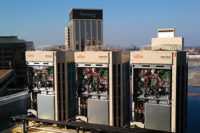With product maturity, new certification, and the horizon in sight, VRF could be pushing toward widespread usage in the United States — a move that could arguably shift the landscape of the HVAC industry.
Think VRF First
It is energy pricing that has put the United States behind in VRF adoption. That’s one theory Roy Kuczera, senior vice president, Fujitsu General America Inc., suggested.
“VRF is already an HVAC staple in most countries in Europe, Asia, the Middle East, and Australia,” he pointed out. “Decades of higher energy costs in other countries have driven them to seek out energy-efficient HVAC solutions.”
Despite the demand for VRF being less prominent in the United States than it is overseas, some consider this country to be the largest market for VRF in the world.
“The growth potential here is staggering. Significantly increasing awareness and educating clients on the benefits of VRF in this country is important,” said Kevin McNamara, vice president, commercial air conditioning, LG Electronics USA Inc.
“Perhaps the next milestone being reached is exactly that; the HVAC community thinking VRF first for projects as opposed to second. That is what most of us are working towards.”
Education Mandatory
One element that is helping manufacturers to educate and convince their clients to consider VRF first is AHRI’s new certification. According to McNamara, the AHRI 1230 Certified Product Directory for VRF Equipment provides a benchmark for performance and measures this technology’s energy efficiency. This should be a helpful tool as contractors are required to justify their customers’ HVAC expenditures while often fighting for every Leadership in Energy and Environmental Design (LEED) point possible.
“Engineers and contractors rely on performance data when they model buildings,” he explained. “By setting a uniform standard, customers are assured manufacturers’ performance claims are accurate, and that products are rated under consistent conditions enabling fair comparisons.”
The validation of VRF efficiency, as provided by AHRI 1230, brings a new level of efficacy to manufacturers educating the HVAC contractor as to the benefits of VRF technology for the contractor and the consumer.
“The long-term effect of certification is positive for our industry, and will help strengthen the growing market perception that VRF technology is the future of HVAC,” said McNamara. “The continued mainstreaming of the technology is crucial to the industry’s success as well as to owners having comprehensive choices for their buildings.”
Have VRF, Will Travel
Not limited to certain climes or regions, VRF equipment is often praised for its versatility. Marc Zipfel, director of product marketing, Mitsubishi Electric Cooling & Heating, noted that the flexibility of VRF systems gives them the ability to be installed in nearly any building application that can be imagined.
“Any region is well suited for VRF applications and these systems are one of the most flexible commercial HVAC technologies that I can think of,” he said. “They can be used in any climate, especially where the simultaneous cooling and heating abilities are maximized.”
Zipfel went on to explain that one of the prominent applications contractors seem to be using VRF systems for are buildings on the National Register of Historic Places. Buildings on that list are subject to strict regulations on how their structures may be altered.
“VRF systems can be installed in these buildings while still preserving the historic characteristics and not altering the original structure,” he said. “VRF systems are also good for multiple-occupancy buildings such as dormitories, apartments, or condominiums. In
applications like museums or concert halls, where the building load varies greatly, VRF can easily accommodate the different load requirements of both the large open spaces in the building as well as the smaller office spaces located elsewhere in the building.”
What’s Ahead?
Like every other HVAC industry segment, the road ahead of VRF is uncertain. There is not a promise of widespread VRF adoption; however, this system’s usage is growing in popularity. AHRI certification, increasing energy prices, and a rising green consciousness are pushing American consumers and HVAC contractors to continue their quest for highly efficient equipment.
“Ten years ago, very few contractors and engineers were familiar with VRF in the United States. About five years ago, during the time when energy prices spiked in the United States, there was a sudden increase in interest in efficient HVAC systems,” explained Kuczera.
“From this point forward, we went from very few engineers knowing about VRF to today, where most engineers and contractors have a basic understanding of VRF.”
Sidebar: Daikin Joins AHRI
ARLINGTON, Va. — The Air-Conditioning, Heating, and Refrigeration Institute (AHRI) announced that Daikin Industries Ltd. applied for full membership in the association last month. According to AHRI, Daikin’s decision is significant because parent companies normally delegate association membership to the applicable subsidiaries within the company.
“We are pleased to accept Daikin Industries Ltd. as a full member of AHRI,” said Stephen Yurek, president and CEO of AHRI. “We view its interest in and commitment to our association as a validation of AHRI’s position as a global leader of the HVACR and water heating industry.”
Daikin Industries expressed interest in joining AHRI based on the global reach of its standards and certification programs. Representatives from Daikin met at AHRI headquarters in mid-October to communicate the manufacturer’s decision to be a full member of the association. Daikin companies Daikin America Inc., McQuay International, and AAF International will represent the parent company on 13 AHRI product sections and subsections, including Chemicals and Refrigerant Reclaimers and Air Filtration and Ultraviolet Light.
For more information, visit www.ahrinet.org.
Publication date: 11/21/2011










